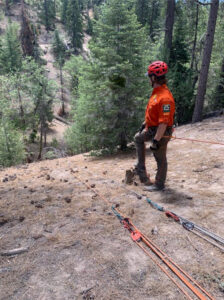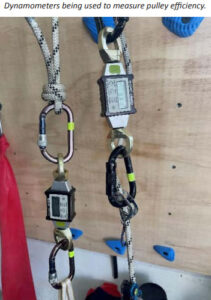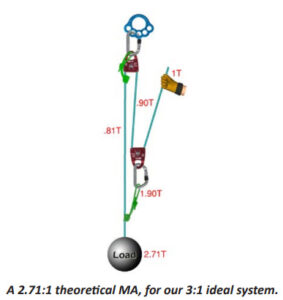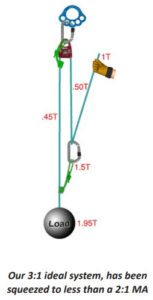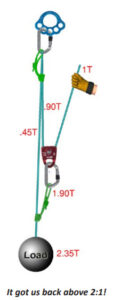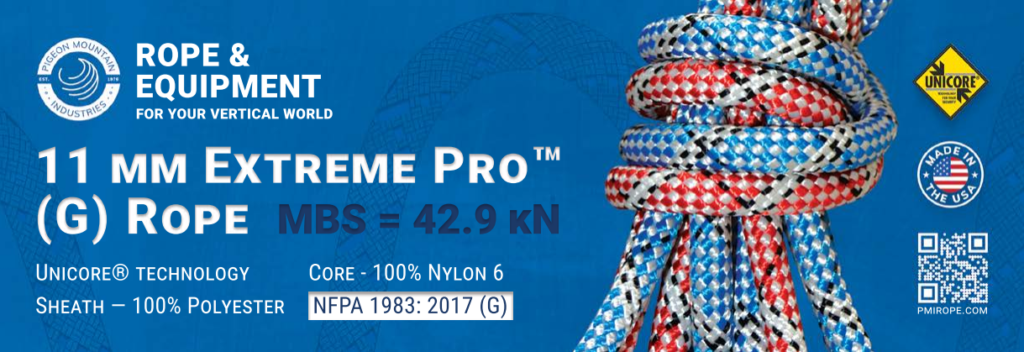Justin Wheaton – Meridian Editor
The San Bernardino County Sheriff’s Volunteer Forces Unit puts on a Rope Rescue Operator course every year. This course is the most basic introduction to rope rescue systems and application. The class builds a solid foundation based on our mission profile to allow teams to integrate on assignments. Primarily, the students will learn a few systems and a progression of mechanical advantages. The last two days of the course are repetitive application of the skills in a realistic scenario. On the final day of our Rope Rescue Operator course, a great debrief discussion came up during the final test evolution. Both groups that tested that day were challenged to lift a 4 person load up a moderate slope using a 3:1 mechanical advantage (MA) with the DCTTRS system they had built. The decision was quickly made by both teams to reconfigure the pulleys to a simple 5:1 MA – Great Work! As the raise continued, the two groups were faced with another decision, this time, they diverged. One team decided to redirect the haul downhill, while the other team did not. Given the slope of the hill and the length of the haul field, hauling down hill was a reasonable decision. When rigging the redirect to haul downhill the team realized they did not have more pulleys left in the cache. They decided they were going to build the redirect with carabiners, another reasonable decision given the tools at hand. At this time, a few extra pulleys were provided by some instructors, and it was said that we would debrief on why after the scenario. So why the pulleys and not the carabiners?
The redirected haul system being hauled down hill. The DCTTRS system set up with 5:1 MA’s and waiting to begin raising.
Before we explain why, it’s important to understand the difference between ideal MA, and theoretical MA. First, ideal MA is a broad estimate, designed to make decision making and evaluation easy in the field. This is how we almost always discuss MA – 3:1, 5:1, 9:1 and so on. These figures do not take into consideration many factors, but for simplicity’s sake, let’s look at the big one, efficiency. To calculate a theoretical MA, we must consider the efficiency of the pulleys in our system. The higher the efficiency, the higher the MA, the lower the efficiency, you guessed it – The lower the MA. By using the “T” system for determining ideal MA and subtracting the inefficiencies it is not difficult to calculate a theoretical MA. This calculation is still “theoretical” because we are only accounting for pulley inefficiencies. To figure out the actual MA can be difficult to do in an equation. You may need to consider the angles rope enter and exit pulleys, the ropes construction, force acceleration such as bouncing, and a host of other factors. However, we can measure the actual MA very simply by measuring input force and output force with scales called dynamometers.
Dynamometers being used to measure pulley efficiency.
So how does the carabiner being used as a redirect reduce my systems theoretical MA to a 2:1? Well, that’s the fun part. As tension is introduced into your system by hauling, the efficiency of each pulley strips away your MA turn by turn. Like water moving through a water line into your home from the street, the larger pipes in the street full of water volume are reduced to the smaller pipes in your home, that change from large to small creates the water pressure in your home. To understand what this has to do with reducing MA, let’s flip it around. If I had small water lines in the street, and large pipes in my home, the small pipes would never fill the large ones in my home, and I would have no water pressure. No one likes a drizzly shower. A similar thing happens when we put our hauling tension into rope, that is then squeezed through an inefficient carabiner, before it goes through an efficient pulley. It deprives our system of much needed tension, like the big pipe deprived me of a good shower.
To demonstrate this, we will use the “T” method for determining MA, but we will show the theoretical MA by subtracting the efficiency from each pulley. Let’s say our system pulleys are 90% efficient, that’s about average for pulleys you see in rescue. And for the carabiner being used as a pulley, the efficiency is about 50%.
In a typical 3:1, If each pulley is 90% efficient, our tension is reduced by 10% at each turn.
Let’s then say you only have 1 pulley with you. You decide to put it at the progress capture location to mind the prusik. Reasonable decision. However, that carabiner is going to reduce our tension by 50%
Then we will reverse the two. It presents operational issues but let’s see what it does to our mechanical advantage.
Now Let’s apply this concept to the 5:1 system in our story. Here is the theoretical MA to a simple 5:1.
Next, we will redirect our haul. We have no more pulleys, but we have tons of carabiners! Remember a redirect adds no mechanical advantage, but we rarely consider what it is taking away.
Using the exact same gear, and what we have just learned, the easiest way to regain some of that mechanical advantage would be to use the carabiner as a pulley further down the system.
Our systems are never truly what they seem. And we are often tasked with doing the best we can with what we have. It’s not easy to calculate your actual mechanical advantage in the field, and it is typically not necessary to do so. But with this information, we can figure out what our theoretical mechanical advantage is. Some small changes to our rigging can make a considerable difference.
As with most things rigging there are many layers. You can always dig deeper and expand on your knowledge. If you would like to learn more about pulley efficiencies in rope systems, please check out these articles on pulley efficiencies in mechanical advantage progression, and an analysis on a systems overall efficiency as a function of the number of pulleys!


